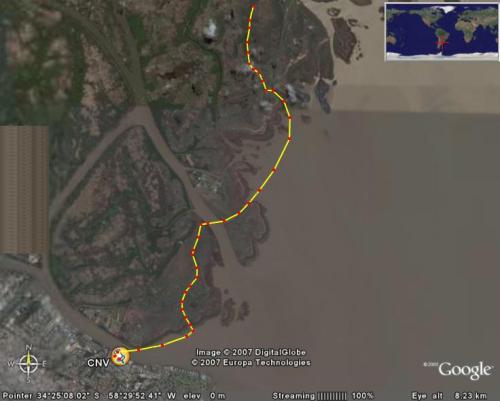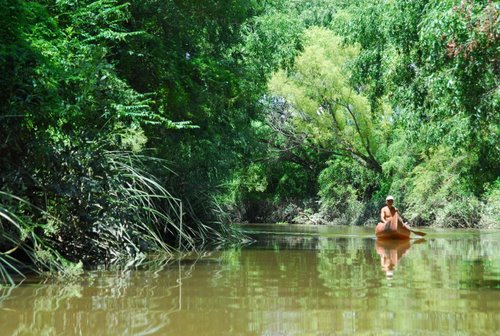Kayaking the Mouth of the Parana River, Argentina

Kayaking the Mouth of the Parana River
In British Columbia’s lower mainland (Greater Vancouver) we are blessed with the ocean at our doorstep and a broad range of parks and protected areas just minutes outside the city. In winter you can ski or snowshoe on the local mountains and in summer you can sail on the ocean, canoe on a local lake or fish one of the many rivers nearby.
The Parana River originates in Brazil, and then flows southward forming a natural boundary between Brazil and Paraguay until it reaches and then joins the Iguazu River. Just above the confluence though, the Parana is dammed by the world’s largest hydro development, the Itaipu Dam. In 2005, this massive hydroelectric plant provided power for over 90% of Paraguay and approximately 20% of Brazil. This one hydroelectric dam produces enough power for the entire state of California alone. Certainly these are admirable achievements and hydro power is often considered ‘clean power’ (compared with coal power for example). But, there were significant social and environmental consequences associated with its construction. Over 10,000 families were forced to relocate when the dam was constructed and the dam’s 1350 square kilometer reservoir drowned Sete Quedas, a set of waterfalls that was apparently as impressive as those at Iguazu. The impacts on wildlife and fisheries were significant but I was not able to find much information about that. What I did find was this report. http://www.american.edu/TED/itaipu.htm
After merging with the Iguazu, the Parana River forms the natural boundary between Paraguay and Argentina. It then turns south, and many hundreds of kilometers later it merges with the Uruguay River to form the Río de la Plata and empties into the Atlantic Ocean. The city of Buenos Aires is located along the Rio de la Plata (not the Atlantic as many might think).

Our Route through the Channels
It was in amongst the canals and wetlands of the estuary of the Parana that we were kayaking. We were accompanied by a fabulous naturalist (thanks Liliana) who was very well versed in the flora and fauna of the region, as well as a world renowned expedition kayaker and kayak designer (thanks Ricardo). We saw kingfishers, a range of songbirds and we even caught a glimpse of an owl that we spooked as we slid along the canals. A wonderful way to experience a very unique region of Argentina.

Paddling Along a Channel of the Parana River
Hi Jessie
Great to hear from you ... and sorry for my delayed reply. I recently returned from Antarctica and will soon add some more blog posts and pictures. I did though want to respond to your question about the Towers in Torres del Paine. My geology knowledge is limited so I sent a note to the Denis St-Onge one of Canada's premier geologists (and Past President of the Royal Canadian Geographical Society) and asked him about the towers. Here is his response:
Good morning Danny,
Without doubt, one of the major attractions of the park is the Paine Massif, mostly composed of granite, and originated 12 million years ago. The highest peak is the Paine Grande (3050 m), although the most representative peaks are the "Cuernos del Paine" featured on most pictures of the park. The Torres del Paine are three sheer granite towers, that make a challenging and coveted prize for climbers .
12 million makes this granite relatively young, remember the oldest dated rock is the Acasta gneiss (west of the Coppermine River) collected by Dr. Janet King and dated at 4,03 billion years! It is likely that this 'young' granite was produced by the cooling of magma at some depth in the earth's crust and then exposed by the erosion of rocks that originally overlaid the magma allowing it to cool slowly and form the crystals typical of granites.
Cheers Danny all is well here and Spring is peaking its nose ever so timidly.
Denis
Hello Olivia and thank you for your note. Yes, I did see dolpins in the Amazon River. There are actually two species of dolphin that you can see in the Amazon. One is very small and grey coloured, the Tucuxi Dolphin. The other species is known as the Amazon River Dolphin (or Boto) and is almost a pink or red colour. I was lucky to see both species although my photos are not that good. If you did an internet search of these two species I am sure you will find some good photos of them. Thanks for your question and say hello to your classmates Hannah and Emily.
Cheers
Danny
Hola Danny,
Pinky here. I am glad to see you are on another long journey. I am also glad to see that you found some gatos a while back. I would like to be stowed away in your pocket so I could see the antarctic, since my friends Carol and Steve haven't found their way that far south yet.
Safe travels,
Pinky
 Funded by TEK
Funded by TEK
Hi Danny,
Speaking of amazing ocean at our doorstep, I was paddling in Indian Arm this past weekend and it was great! However, probably not nearly as exotic as, and definitely not as warm as, paddling the Parana River. It looks very cool! I actually had a question for you from a few entries back. The Towers in Torres del Paine National Park, what are they exactly? I do know that they are granite, but how did they get the way that they are? E.g. are they remnant volcanic necks (not knowing much about the geography of Chile), or just granite monoliths, or is it an unknown? Just curious. Midterm season has arrived here in the world of 1st year FWR, but we are all still kickin'! We are enjoying your site, all the best and take care in the next phase of your journey.
Happy travelling,
Jessie